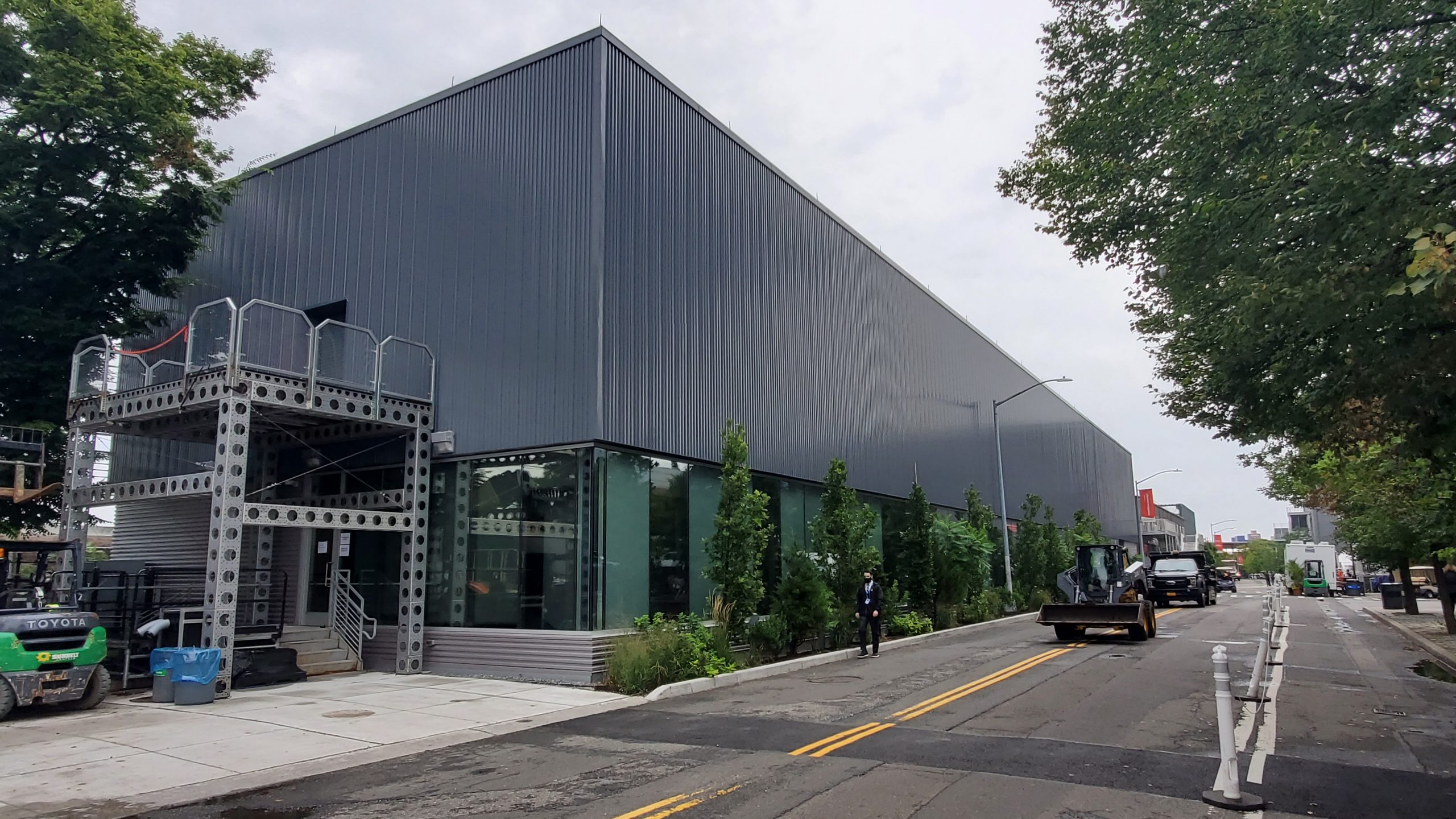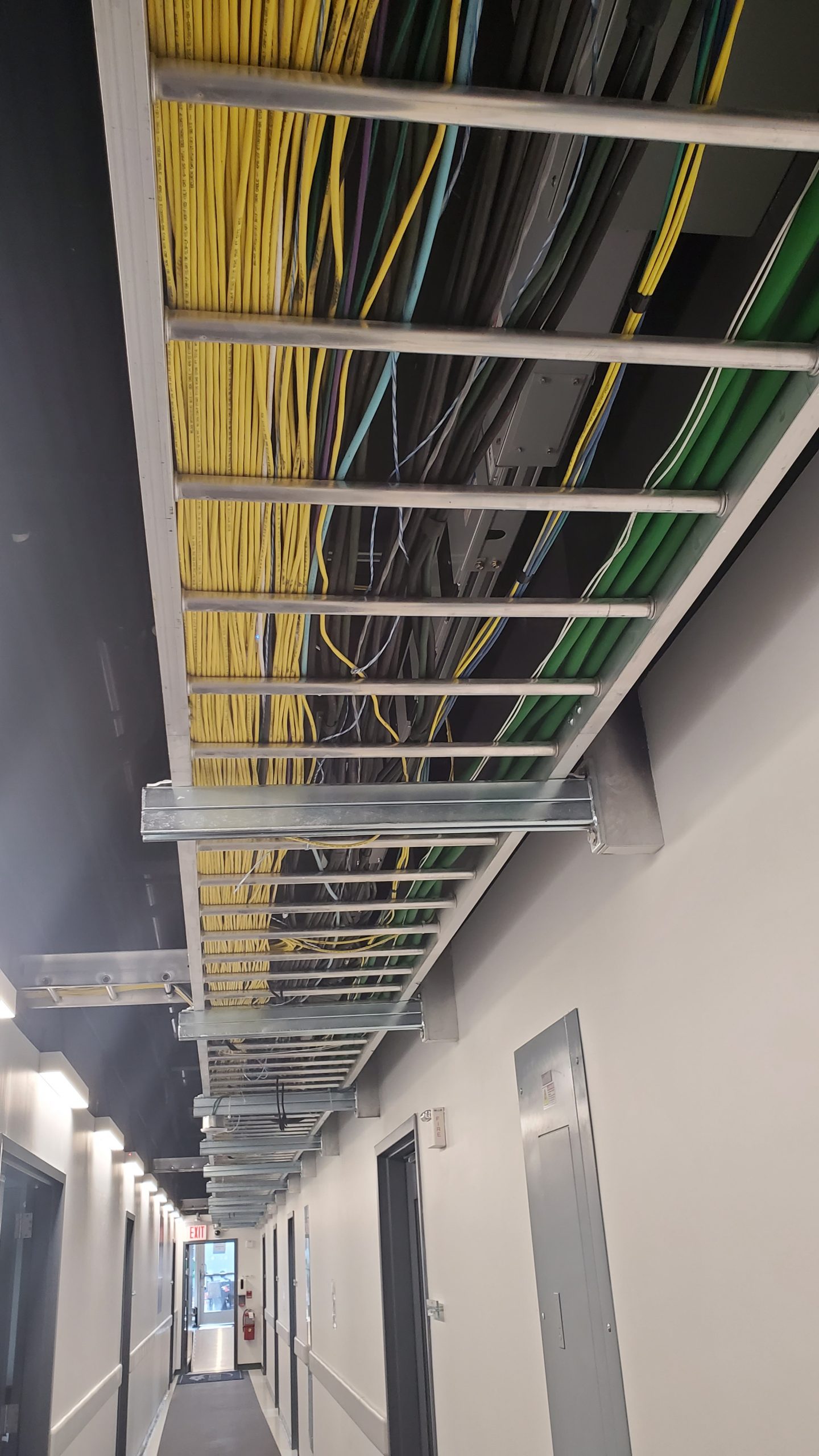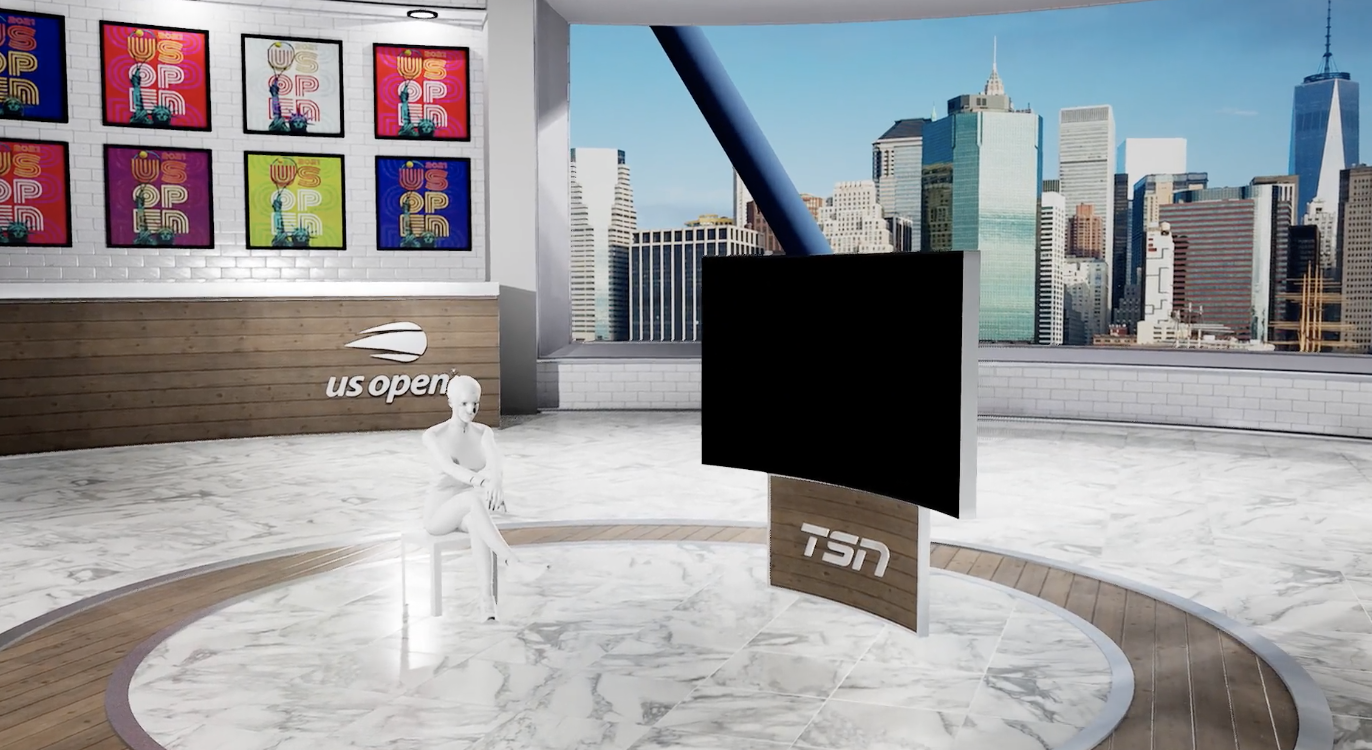Live From the US Open: USTA’s Patti Fallick on the Return of Broadcasters and Ida’s Stormy Impact
Story Highlights
The US Open tennis tournament TV production team heads into its first full weekend of tennis expecting full stands, clear skies, and, hopefully, smooth sailing. And it’s well deserved after a challenging first week that saw the remnants of Hurricane Ida whip across the Billie Jean King Tennis Center on Wednesday night and a final two months of preparation that had to evolve due to the ever-changing COVID-19 pandemic travel and safety protocols, and, yes, another tropical storm that delayed set up on August 21.

The USTA’s US Open Broadcast Building is home to the USTA production team, rights holders, and technical facilities,
Patti Fallick, USTA, Managing Director, Broadcast, credits her team as well as key partners like NEP, Gravity Media, Veritone, Lumen, The Switch, SMT, Veritone and Thumbwar with making a difference by working well together.
“We could not do this global event seamlessly without all of them,” she says. “And more importantly is our partnership with ESPN as they are our domestic broadcast rights holder and host broadcaster for the world feed. They really make it happen for us and help us get the US Open to the world. Without the partnership of Jamie Reynolds, ESPN, VP, production, and his team this production doesn’t happen.”
At the center of the efforts is a broadcast compound that continues to evolve. It features a building that houses ESPN’s production offices, a second that is home to ESPN’s unilateral and world feed operations and a technical core managed by Gravity Media, and a third USTA Broadcast Building that contains USTA broadcast offices, US Open radio operations, Eurosport, Wowow, and Prime Video production and technical operations, world feed news gathering and features, communications operations, archiving, transmission, the technical operations center for world feeds, USTA digital operations, and the virtual studio control room (the actual virtual studio is inside Arthur Ashe Stadium). NEP’s Chromium truck is next door and is home to the world feed production.

Permanent fiber cabling in across the Billie Jean King Tennis Center made a big difference for rights holders and the USTA.
“Like last year, we had editing and logging done off site and SMT also has a operation that is off site,” says Fallick. “Last year when those operations couldn’t be here on site, we came up with the technology to make sure they could work remotely and kudos to the guys from Veritone and Thumbwar for coming up with solutions that allowed us to work remotely seamlessly. And our digital shows are also being edited off site.”
The US Open Broadcast Building has seen some improvements since last year, most notably the installation of permanent fiber in the broadcast building.
“We don’t have to re-run fiber every year and it’s a huge game changer,” says Fallick. “It’s saved rights holders thousands of dollars that they can put into the coverage and overall production. We also designed the broadcast building to each broadcaster’s technical specifications for heat load and power to ensure their technical spaces were protected.
A popular area within the Broadcast Building is the virtual studio control room which is tied into a green screen studio located in Arthur Ashe Stadium. The set up allows for players to step into the green screen studio, take a seat, and then do interviews with broadcasters from around the world via a large monitor.
“The players feel very comfortable, and they can do multiple interviews with rights holders without having to go to different places around the tennis center,” says Fallick. “It’s worked out quite well and we’ve found the players tend to stay and talk longer because they don’t feel the pressure to leave and go to the next thing. And then we also were able to tie that in to Eurosport and their Cube which they loved.”
Viewers at home, meanwhile, see the player sitting in a virtual environment that has artwork that pulses with New York City energy.
“New York City resonates with our rights holders and then we customize the virtual set with each rights holder’s logo,” adds Fallick.
As of September 3, the system was used for 70 interviews, giving rights holders who can’t be on site a presence. Priority is given to rights holders who are home countries to players coming off the court and post-match interviews are limited to one rights holder, so players aren’t there too long.
“Last year the Creative Technologies Group at NEP scrambled to figure something out and this year they elevated it to a whole new level,” says Fallick. “It’s not inexpensive but the exposure we get from it is extraordinary. We’ll probably keep on doing this for a long time as it has been seamless this year. Last year it took a little while of educating people, to this new virtual world and now they feel comfortable and it’s worked out quite well.
Stormy Weather
The biggest challenge the opening week had nothing to do with actual production and everything to do with mother nature as the remnants of Hurricane Ida descended with a furious rain (three inches in an hour reported in Central Park, a record) and winds on Wednesday night that caused chaos across the tri-state area.
“It was around seven when all of our phones went off with a flash flood warning,” says Fallick of the first ever flash flood warning to be sent out in New York City. “And we have an on-site meteorologist that is the best at what they do so we could quickly see there were potential tornadoes and the potential for heavy downpours. But nobody realized how quickly it was going to hit.”
Key to keeping everyone safe was a new text alert system that was put in to deliver critical messages to everyone who was credentialed.
“This year our IT system put in a new alert system which worked flawlessly and allowed us to communicate with everybody that comes on site with different levels of alerts,” says Fallick. “It’s a really great tool that enabled us to be even more safe.”
Once the storm hit fans were moved from across the venue to inside of Arthur Ashe Stadium to shelter. Then the subway lines and the Long Island Railroad, the most popular ways of getting into and out of the US Open, were shut down.
“The roads were flooded, and it was a horrible situation,” says Fallick. “But thankfully the Mets game at Citifield was cancelled early and the NYPD was able to redeploy their policemen from that venue to us and that was great.”
The next challenge on Wednesday night/Thursday morning was figuring out how to get rights holders and production personnel back to their homes and hotels safely. Many of the rights holders stay in Manhattan and Fallick says Danny Zausner, USTA National Tennis Center, COO, committed to getting everyone home safely.
“We had big buses and sprinter vans dropping fans off at their homes all over Long Island, Brooklyn, and Connecticut,” she says. “And we did the same and we everyone did it with good humor. Mary Carillo is one of our announcers and she told me ‘I’ll stay here as long as I need to, I can sleep here,’ and I said ‘great, but hopefully that doesn’t need to happen.”
It didn’t, thankfully, and the night ended at around 3:30 am with Fallick and the team on a bus ride to the hotel after ensuring that all rights holders and staff got back to hotels and homes safely.
The late night was one of the reasons the play on Thursday was delayed as the team needed a chance to get back in the morning and assess any damage.
“We were very afraid, and our biggest fear was things like the electronic line calling and would we be able to broadcast,” she says. “There were a few things like a net with a Netcam that was stored off court in an area that was under four feet of water, but it could have been a lot worse. But the ESPN operations team, Gravity Media team and Nick Romano, NEP engineering manager and our team went through everything to make sure we were good to go.”
Production Changes
From a production standpoint the biggest news this year is coverage of all the courts for all the matches.
“We’ve never done that before,” says Fallick. “We are covering all the qualifying matches, all the main draw matches, all wheelchair matches, and all junior matches and that was a bit of a challenge to figure out. But with the automated ACES system that ESPN has developed it’s worked out great, along with our linear broadcast courts.”
There have also been some tweaks to last year’s coverage with ESPN moving the two-point camera system to give a new look to coverage of the grounds. And the biggest changes inside Arthur Ashe Stadium are a result of adjusting to fans back in the stands. Last year the lack of fans gave ESPN and US Open production teams a tremendous amount of flexibility with respect to camera positions and more. For example, a manned camera was located in a portion of the stands located right off the corner of one of the baselines. But with fans back that position was not available so ESPN, the USTA, and Gravity Media worked together to get a robotic camera installed in the wall behind the baseline to replicate that angle.
“It has a six-inch lens and it’s definitely a more intimate shot and gives ESPN a lower angle to cover the event which has been awesome,” says Fallick. “And when we challenged the ESPN team to figure out a way to mask it a little bit more, they figured it out by the next morning. I am beyond impressed with the group, led by Sam Olson and Steve Raymond, two engineers who just don’t get rattled when they are challenged to figure out things. This event is a massive just based on the number of cameras alone that are in use but then they also make sure we’re able to support electronic line calling and VAR.”
The practice courts have also been enhanced with NEP/Fletcher robotic cameras so that rights holders can grab shots of players for use on a linear show or even stream it straight to viewers.
“It’s another opportunity for them to showcase the event on the digital platforms that are driving everything,” says Fallick. “The main linear channel is becoming less and less of a focus and more and more it is about of the amount of content you can put on the digital channels.”
Fallick says Veritone is on hand to oversee the US Open digital media hub and live event services as four Boardwalk ENG crews are shooting nonstop and putting up content for rights holders.
“It’s just feeding the machine and giving the rights holders content to support the storytelling,” says Fallick. “There are great stories that develop around players, and we’ll send out our crews to get more player content, iso footage as well as covering the overall flavor of the US Open grounds.” We also added a racing drone this year to capture the beauty of our venue. “
Gearing Up for COVID-19
In the ramp up to this year’s event Fallick once again found herself becoming an expert on not only COVID-19 protocols but also Visa applications and more for the hundreds of rights holders that come in for the event.
“Back in June we were planning to be in great shape as everybody was getting vaccinated, the numbers in New York were low, and the rest of the world was coming back,” says Fallick. “But that was before the Delta variant and then things swung back the other direction and being able to react quickly to that was critical.”
The USTA TV compound requires everyone to be vaccinated, the wearing of masks when indoors, and a catering area that is completely open to the elements to ensure steady air flow and ventilation.
Anyone handling an event that attracts broadcasters from around the globe will face similar challenges in the coming months. Can they get into the country? Are they fully vaccinated?
“One of the things we did in 2020 was we held partner briefings with our sponsors and our broadcasters with full transparency,” says Fallick. “We asked that everything be kept confidential, but we told them exactly what was going on and we allowed them to ask us questions.”
This year the belief was those briefings would not need to be held as regularly but when the COVID situation shifted it was important to get back into the habit of multiple partner summits.
The US Open is the biggest sports event to date to require vaccinations for those broadcasters, media and staff working on the event, as well as fans and Fallick says that is a big reason why everybody feels comfortable being in the building.
“It’s just a comfort level and I don’t think you could do this if you’re worrying about whether this person I am talking to is unvaccinated,”
Other steps taken to improve safety is air filtration units throughout the broadcast building and venue.

